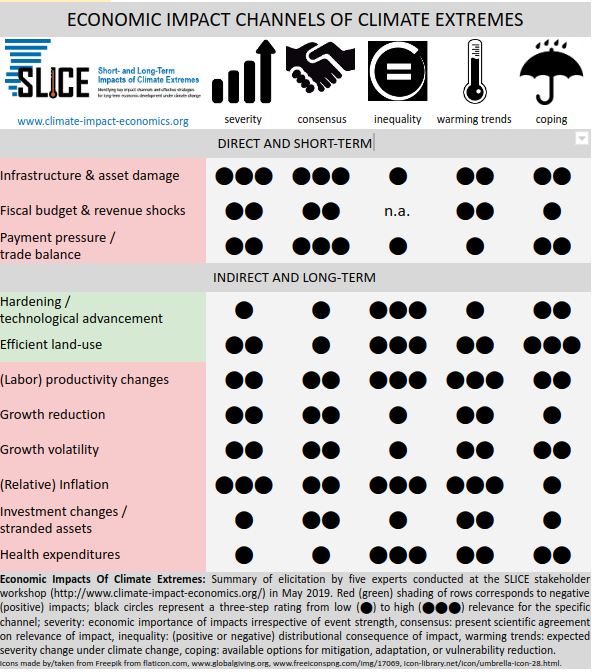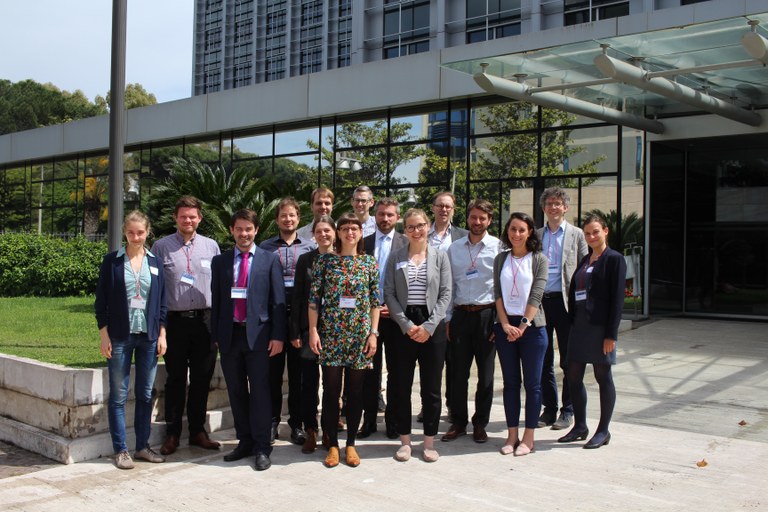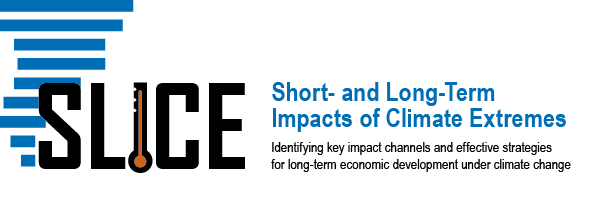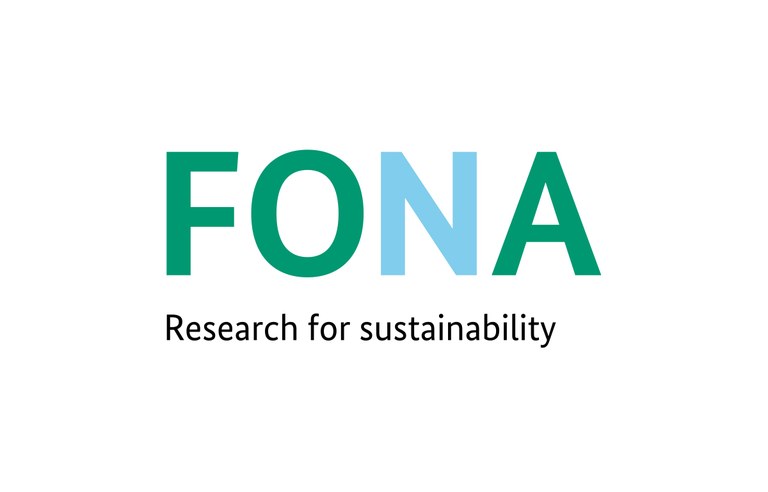Outcome of SLICE Stakeholder Workshop
GOALS OF THE SLICE STAKEHOLDER WORKSHOP
Climate extremes such as floods, tropical cyclones, heatwaves, and droughts cause not only substantial direct damages but also have the potential to deteriorate socio-economic development perspectives in the long-term. However, a systematic understanding of the main impact channels of climate extremes on socio-economic development from the household to the macroeconomic level is still missing.
This research gap needs to be addressed not only with regard to future climate impact assessments, such as the upcoming 6th IPCC assessment report. Equally important,
practitioners from international institutions and the private sectors are in need of systematic quantifications of climate extremes’ impacts on society and economy to assess the merits and limits of coping strategies ranging from physical adaptation to disaster insurance schemes.
This workshop aimed at bringing together climate impact researchers with stakeholders and practitioners from international institutions and the private sector to outline a research framework towards a comprehensive assessment of climate risks and the development of tailored coping strategies.
Discussions were guided by the following key questions:
- What is the current status quo of research on the short- and long-term socio-economic impacts of climate extremes? What are shortcomings in conceptual understanding, empirical data, and modeling tools, to date?
- What are the needs of stakeholders, and how can these be best addressed by the scientific community?
- What achievements would constitute a break-through in this field within the next three years?
STRUCTURE OF THE WORKSHOP
The two-day workshop was organized by the recently launched “Short- and Long-Term Impacts of Climate Extremes” (SLICE) - Project partnered by PIK, ifo, Climate Analytics, and ETH Zürich and took place at the IFAD headquarters in Rome, Italy. It brought together climate impact researchers and stakeholders from national and international institutions, and the private sector (see list of participants below).
A large part of the workshop was dedicated to stakeholder perspectives on the research agenda of SLICE as well as respective stakeholder expectations and contributions to foster relevant research on the socio-economic impacts of climate change. Two breakout groups dealt with a) the understanding of climate impacts from the household to the macroeconomic level, and b) strategies to cope with financial risks from climate extremes.
MAIN OUTCOMES
Which factors have to be considered for a comprehensive assessment of short- and long-term socioeconomic impacts of climate extremes?
A systematic assessment of the short- and long-term impacts of climate extremes requires the build-up of a comprehensive modeling chain from bio-physical hazard indicators (e.g., flooded area or drought affected regions) over direct economic losses (e.g., crop failures or asset losses) to the long-term socioeconomic impacts (e.g., reduction in household income or labor productivity). Basing the socio-economic impact modeling on process-based bio-physical impact models and reported data allows to gain a profound understanding of the relative importance of the different impact channels (e.g., impacts of climate extremes on education of vulnerable populations, changes in exposure driven by population growth and socioeconomic development). This process-based approach permits to disentangle climate change contributions from other drivers such as socio-economic development. This is key to i) attribute the contribution of climate change to past disasters, and ii) make reliable projections of climate change impacts under different climate change and socio-economic scenarios. Since the relative importance of impact channels strongly differs between countries, a solid microfoundation is required for the macro-economic modeling. In the SLICE context this will be realized by household level studies based on panel survey data in four focus countries; focus regions discussed at the workshop included Uganda, Tanzania, Nigeria, the Philippines and Mongolia.
What are the main impact channels through which climate change affects socio-economic development (on the household as well as country level, for low-income as well as industrialized countries)? How to increase resilience?
On the macroeconomic level, persistent losses of labor productivity, total factor productivity, and physical capital have been identified as key impact channels through which climate extremes can hamper socio-economic development of countries in the long term. Further, international disaster recovery aid and access to capital markets have been identified as effective coping strategy accelerating post-disaster recovery, especially in disaster-prone developing countries.
On the household level, reduced access to, and spending on, education and health care have been identified as two key impact channels of climate extremes to be investigated in the project. Both channels can be triggered by the need for reconstruction of destroyed assets and critical infrastructure but also by a disaster-induced increase in food prices. Reduced spending on education may not only reduce the knowledge access and the level of education but also the risk awareness of poorer populations, increasing their vulnerability, and reducing their coping and adaptive capacity. The same holds true for reduced spending on healthcare, which may worsen health conditions or have adverse impacts on local health insurance systems. As health is a precondition for education, these channels also interact with each other, and both aspects may reduce labor productivity in the long term. For all these reasons, understanding local impacts on health and education is key for stakeholders to develop, prioritize, and implement evidence-based coping strategies.
As a systematic way to create resilience towards the identified impact channels, priority mapping of effective coping and adaptation strategies can be a valid option for stakeholders. Therefore, possible entry and priority points for their implementation have to be found, by means of empirical analyses on possible adaptation measures in order to understand where adaptation already takes place, which methods are already applied, how effective and affordable they are.
In an expert elicitation among participating stakeholders, a more detailed list of impact channels was identified. It summarises the current knowledge on if and how (severe) climate extremes can economically affect societies in the short- and long-term and provides a rating of coping capacities with respect to individual impact channels.

What output of the SLICE project will be stakeholder relevant? What achievements would stakeholders consider a break-through in the next three years?
In the plenary discussions and especially during the breakout sessions, several possible key project results that are of high relevance for stakeholders were identified:
- Reliable estimates of direct, region-specific damages caused by climate extremes at the present level of global warming (ca. 1°C above pre-industrial 1850 level) as well as at warming levels of 1.5°-2°C in line with the long-term temperature goal of the Paris Agreement, and at higher warming levels that are most likely to occur under unmitigated greenhouse gas emissions. These will help to disclose physical and transitional risks arising from climate change. Understanding these risks is crucial to develop effective insurance solutions.
- Development of multi-dimensional well-being metrics. These metrics should capture the relatively higher vulnerability of poor - often rural - populations, which is only poorly captured by one-dimensional (monetary metrics) such as GDP, expenditure, or income.
- A research focus should be put on rural areas as, until to date, research and policy recommendations have been often focussed on urban development. In this context, droughts are of major importance, since they can have adverse long-term impacts on rural poverty and trigger migratory movements.
- To better link the project to ongoing political discussions, the impacts of extreme events and the efficiencies coping strategies should be assessed in the context of the Sustainable Development Goals.




